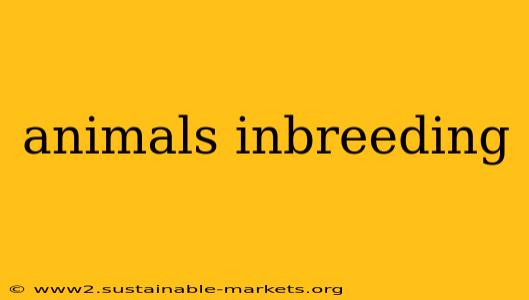Inbreeding, the mating of closely related individuals, is a phenomenon with significant consequences for animal populations, both in the wild and in captivity. While it might seem like a simple breeding practice, the genetic ramifications are far-reaching and often detrimental. This article delves into the dangers of inbreeding in animals, exploring the genetic risks, its impact on conservation efforts, and the strategies employed to mitigate its negative effects.
Genetic Risks Associated with Inbreeding
The primary concern with inbreeding is the increased likelihood of homozygosity. This means that offspring inherit two identical copies of a gene, one from each parent. While not inherently harmful, if these identical genes carry recessive alleles (genes that only express themselves when paired with another identical allele), the offspring may develop genetic disorders or display undesirable traits. These disorders can range from minor physical abnormalities to life-threatening conditions, significantly reducing fitness and survival rates.
Increased Risk of Genetic Diseases
Inbred animals are more prone to a range of genetic diseases, including:
- Inherited metabolic disorders: These disorders disrupt the body's chemical processes, often leading to developmental problems or premature death.
- Immune deficiencies: Weakened immune systems make inbred animals more susceptible to infections and diseases.
- Skeletal abnormalities: Malformations of the bones and joints can severely impair an animal's mobility and overall health.
- Reduced fertility: Inbreeding often leads to lower reproductive success, with animals exhibiting decreased fertility and increased infant mortality.
The Impact on Animal Conservation
Inbreeding poses a significant threat to the survival of endangered species and small, isolated populations. The limited genetic diversity in these groups means that there's a higher chance of harmful recessive alleles being passed on to offspring. This can lead to a phenomenon known as inbreeding depression, where the overall health and fitness of the population decline, making it more vulnerable to extinction.
Loss of Genetic Diversity
The loss of genetic diversity is a critical issue in conservation biology. Genetic diversity is essential for a species' ability to adapt to changing environmental conditions, resist diseases, and maintain long-term viability. Inbreeding dramatically reduces this diversity, leaving the population less resilient to challenges.
Strategies for Mitigating Inbreeding
Conservation biologists employ several strategies to combat the effects of inbreeding in threatened animal populations:
- Captive breeding programs: These programs carefully manage breeding pairs to minimize inbreeding and maximize genetic diversity. Sophisticated pedigree analysis helps identify appropriate mating partners.
- Genetic management: Techniques like DNA analysis are used to assess genetic diversity within populations and identify individuals with unique gene combinations.
- Introduction of new individuals: Introducing genetically diverse individuals from other populations can increase the overall genetic diversity and reduce inbreeding.
- Habitat restoration and protection: Protecting and restoring natural habitats can help prevent the isolation of populations and encourage natural gene flow, reducing inbreeding in the wild.
Conclusion
Inbreeding in animals carries significant risks, leading to reduced fitness, increased susceptibility to diseases, and a heightened risk of extinction, especially in endangered species. Understanding the genetic implications of inbreeding and employing proactive conservation strategies are crucial for ensuring the long-term survival of animal populations. Continued research and innovative approaches are essential to address this challenge and protect the biodiversity of our planet.

